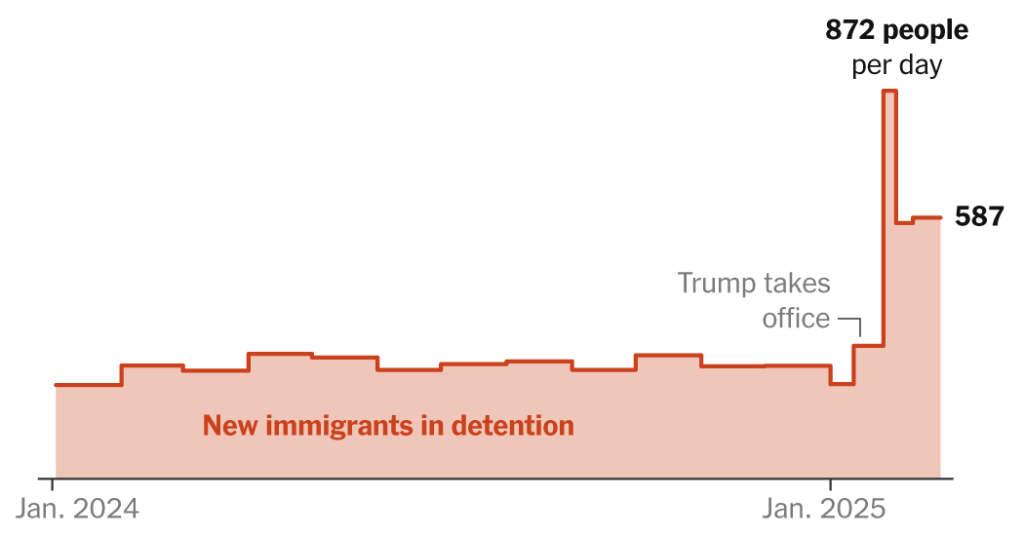The Trump Administration’s Dramatic Shift in Immigration Enforcement
A Surge in Enforcement Under Trump
The Trump administration has implemented a significant escalation in immigration enforcement, marked by a sharp increase in arrests and detentions of immigrants. Recent federal data indicates that in the past month alone, there have been nearly 23,000 arrests and 18,000 deportations. This represents a substantial shift from the policies of the Biden administration, under which ICE arrested and detained approximately 255 people daily. Under President Trump, ICE’s daily arrests have risen dramatically, peaking at 872 people per day in late January before settling to just under 600 per day in early February. This surge in enforcement is part of President Trump’s broader goal of deporting millions of undocumented immigrants from the United States.
Shift in Focus from Border to Interior Enforcement
The Trump administration’s immigration enforcement strategy has shifted significantly compared to the Biden administration. Previously, a majority of immigration arrests and deportations occurred at the southwestern border, with many migrants apprehended while attempting to cross into the U.S. In contrast, the Trump administration has prioritized enforcement within the interior of the country. This shift is evident in the data, which shows that ICE is now focusing more on arresting and detaining immigrants who are already living in the U.S., rather than those caught at the border.
Causes of the Lag in Deportations
Despite the increase in arrests and detentions, deportations under the Trump administration have not kept pace. ICE deported an average of 600 people per day in mid-February, which is a significant decrease from the more than 750 people deported daily during the previous 12 months. Several factors contribute to this lag. One major reason is the Trump administration’s decision to close the border and end asylum programs that were in place during the Biden administration. These programs allowed many migrants to seek humanitarian relief, and their termination has led to fewer arrests at the border and fewer migrants being sent to ICE for detention and deportation.
Overcrowding in ICE Detention Facilities
The increased focus on interior enforcement has led to a significant rise in the number of people being held in ICE detention facilities. The total detained population has grown by more than 4,000 in the past month, reaching nearly 44,000 people. This number exceeds the capacity for which Congress allocated funding, leading to overcrowding in detention centers. The situation is further complicated by the fact that fewer immigrants are being released from detention. While many immigrants were previously allowed to leave detention under certain conditions during the Biden administration, this practice has largely ended under President Trump. ICE has stopped granting parole to detainees almost entirely, and only a small number of people are being released after paying a bond or promising to meet specific conditions.
Changing Demographics of Detainees
The Trump administration has emphasized that its immigration enforcement strategy is focused on detaining and deporting criminals. While a majority of those in detention have been convicted of a crime, the data shows that the share of people detained with no criminal record has grown significantly. Just over 6% of detainees had no criminal charges in mid-January, but this number has since increased to 16%. This shift raises questions about the administration’s claims that its enforcement efforts are primarily targeting dangerous criminals.
Challenges and Future Outlook
Despite the significant increase in arrests and detentions, the Trump administration’s goal of deporting millions of people this year appears to be out of reach, at least at the current pace. While the numbers could still rise, the administration faces several challenges in achieving this objective. Republicans in Congress have proposed additional funding for ICE and other immigration enforcement agencies, and President Trump has sought to expand the military’s role in immigration enforcement. However, the administration’s efforts have been met with resistance from advocacy groups, legal challenges, and logistical hurdles. As the debate over immigration policy continues, the human impact of these enforcement actions will likely remain a central issue in the national conversation.


